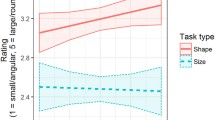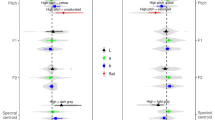Abstract
Sound symbolic words consist of inevitable associations between sounds and meanings. We aimed to identify differences in familiarity, visual imageability, auditory imageability, tactile imageability, emotional valence, and arousal between Japanese sound symbolic words with voiced initial consonants (VCs; dakuon in Japanese; e.g., biribiri) and Japanese sound symbolic words with semi-voiced initial consonants (SVCs; handakuon in Japanese; e.g., piripiri), and between VCs (e.g., daradara) and Japanese sound symbolic words with voiceless initial consonants (VLCs; seion in Japanese; e.g., taratara). First, auditory imageability and arousal were significantly higher in VCs than SVCs, whereas familiarity, tactile imageability, and positive emotion (emotional valence) were significantly higher in SVCs than VCs. Second, visual imageability was higher in VCs than VLCs, while familiarity and positive emotion were higher in VLCs than VCs. Initial consonants in Japanese sound symbolic words could be associated with specific subjective evaluations such as familiarity, visual imageability, auditory imageability, tactile imageability, emotional valence, and arousal.

Similar content being viewed by others
References
Adelman, J. S., Estes, Z., & Cossu, M. (2018). Emotional sound symbolism: Languages rapidly signal valence via phonemes. Cognition, 175, 122–130.
Aryani, A., & Jacobs, A. M. (2018). Affective congruence between sound and meaning of words facilitates semantic decision. Behavioral Sciences, 8(6), 56.
Aryani, A., Conrad, M., Schmidtke, D., & Jacobs, A. (2018a). Why “piss” is ruder than “pee”? The role of sound in affective meaning making. PLoS ONE, 13(6), e0198430.
Aryani, A., Hsu, C. T., & Jacobs, A. M. (2018b). The sound of words evokes affective brain responses. Brain sciences, 8(6), 94.
Aryani, A., Hsu, C. T., & Jacobs, A. M. (2019). Affective iconic words benefit from additional sound-meaning integration in the left amygdala. Human brain mapping, 40(18), 5289–5300.
Aryani, A., Isbilen, E. S., & Christiansen, M. H. (2020). Affective arousal links sound to meaning. Psychological Science, 31(8), 978–986.
Baayen, R. H., Davidson, D. J., & Bates, D. M. (2008). Mixed-effects modeling with crossed random effects for subjects and items. Journal of Memory and Language, 59, 390–412.
Bates, D., Maechler, M., Bolker, B., & Walker, S. (2015). Fitting linear mixed-efects models using lme4. Journal of Statistical Software, 67(1), 1–48.
Bates, D. M. (2005). Fitting linear mixed models in R. R News, 5, 27–30.
Bremner, A. J., Caparos, S., Davidoff, J., de Fockert, J., Linnell, K. J., & Spence, C. (2013). “Bouba” and “Kiki” in Namibia? A remote culture make similar shape-sound matches, but different shape-taste matches to Westerners. Cognition, 126(2), 165–172.
Benjafield, J., & Muckenheim, R. (1989). Dates of entry and measures of imagery, concreteness, goodness, and familiarity for 1,046 words sampled from the Oxford English Dictionary. Behavior Research Methods, Instruments, & Computers, 21(1), 31–52.
Bradley, M. M., & Lang, P. J. (1994). Measuring emotion: The self-assessment manikin and the semantic differential. Journal of Behavioral Therapy and Experimental Psychiatry, 25(1), 49–59.
Coltheart, M. (1981). The MRC Psycholinguistic Database. Quarterly Journal of Experimental Psychology, 33A, 497–505.
Folkins, C., & Lenrow, P. B. (1966). An investigation of the expressive values of graphemes. The Psychological Record, 16(2), 193–200.
Goetry, V., Urbain, S., Morais, J., & Kolinsky, R. (2005). Paths to phonemic awareness in Japanese: Evidence from a training study. Applied Psycholinguistics, 26, 285–309.
Hamano, S. (1998). The sound-symbolic system of Japanese. Studies in Japanese Linguistics, 10, 1–262.
Imai, M., Kita, S., Nagumo, M., & Okada, H. (2008). Sound symbolism facilitates early verb learning. Cognition, 109, 54–65.
Kita, S. (1997). Two-dimensional semantic analysis of Japanese mimetics. Linguistics, 35, 379–415.
Klink, R. R. (2000). Creating brand names with meaning: The use of sound symbolism. Marketing Letters, 11(1), 5–20.
Köhler, W. (1929). Gestalt psychology. New York, USA: Liveright.
Kuznetsova, A., Brockhoff, P. B., & Christensen, R. H. B. (2017). lmerTest package: Tests in linear mixed effects models. Journal of Statistical Software, 82(13), 1–26.
Lang, P. J. (1980). Behavioral treatment and bio-behavioral assessment: Computer applications. In J. B. Sidowski, J. H. Johnson, & T. A. Williams (Eds.), Technology in mental health care delivery systems (pp. 119–137). Norwood, NJ: Ablex Publishing.
Monaghan, P., Christiansen, M. H., & Chater, N. (2007). The phonological-distributional coherence hypothesis: Cross-linguistic evidence in language acquisition. Cognitive Psychology, 55(4), 259–305.
Myers-Schulz, B., Pujara, M., Wolf, R. C., & Koenigs, M. (2013). Inherent emotional quality of human speech sounds. Cognition & Emotion, 27(6), 1105–1113.
Ono, M. (Ed.). (2007). Nihongo onomatope jiten [Japanese onomatopoeia dictionary]. Tokyo, Japan: Shogakukan.
R Core Team. (2019). R: A language and environment for statistical computing. R Foundation for Statistical Computing. http://www.r-project.org/.
Ramachandran, V. S., & Hubbard, E. M. (2001). Synaesthesia: A window into perception, thought, and language. Journal of Consciousness Studies, 8(12), 3–34.
Sapir, E. (1929). A study in phonetic symbolism. Journal of Experimental Psychology, 12, 225–239.
Westbury, C. (2005). Implicit sound symbolism in lexical access: Evidence from an interference task. Brain and Language, 93, 10–19.
Wilson, M. D. (1988). The MRC psycholinguistic database: Machine readable dictionary, version 2. Behavior Research Methods, Instruments and Computers, 20, 6–11.
Yao, Z., Wu, J., Zhang, Y., & Wang, Z. (2017). Norms of valence, arousal, concreteness, familiarity, imageability, and context availability for 1,100 Chinese words. Behavior Research Methods, 49(4), 1374–1385.
Yee, L. T. S. (2017). Valence, arousal, familiarity, concreteness, and imageability ratings for 292 two-character Chinese nouns in Cantonese speakers in Hong Kong. PLoS ONE, 12(3), e0174569.
Acknowledgements
The authors were supported by Hiroshima University Grant-in-Aid for Scientific Research (to TK), KAKENHI Grant-in-Aid for Research Activity Start-up (to TK), and KAKENHI Grant-in-Aid for Early-Career Scientists (to TK and TU). This research was conducted as part of the School of Education Joint Research Project 2020 at Hiroshima University, and received research support from the School of Education. We would like to thank Editage (www.editage.com) for English language editing.
Author information
Authors and Affiliations
Corresponding author
Ethics declarations
Conflicts of interest
The authors declare no conflict of interest.
Additional information
Publisher's Note
Springer Nature remains neutral with regard to jurisdictional claims in published maps and institutional affiliations.
Rights and permissions
About this article
Cite this article
Kambara, T., Umemura, T. The Relationships Between Initial Consonants in Japanese Sound Symbolic Words and Familiarity, Multi-Sensory Imageability, Emotional Valence, and Arousal. J Psycholinguist Res 50, 831–842 (2021). https://doi.org/10.1007/s10936-020-09749-w
Accepted:
Published:
Issue Date:
DOI: https://doi.org/10.1007/s10936-020-09749-w




